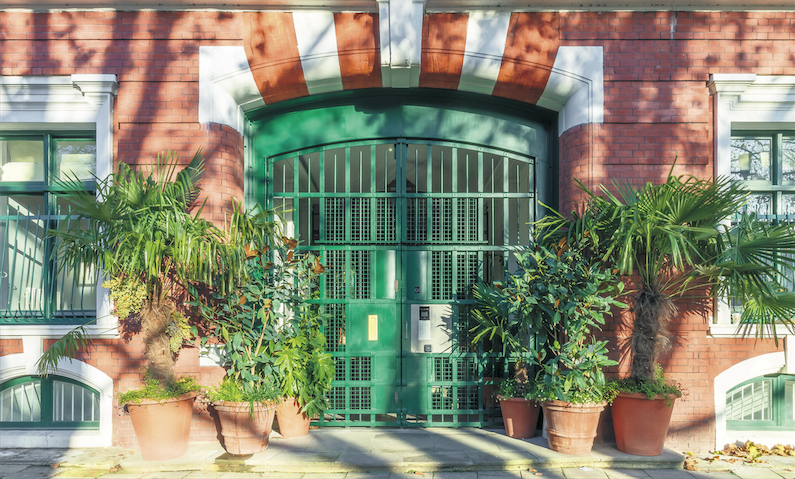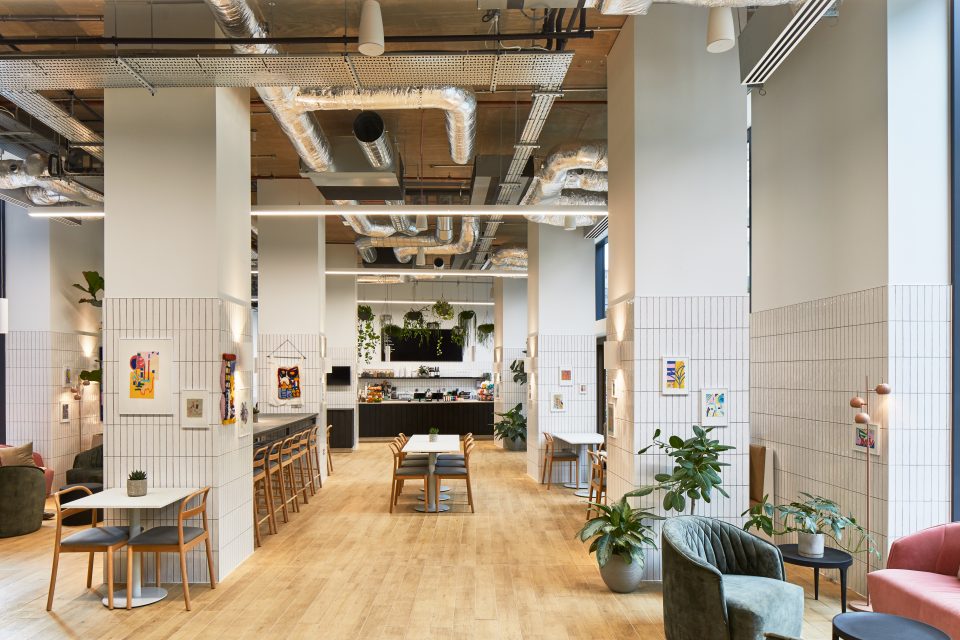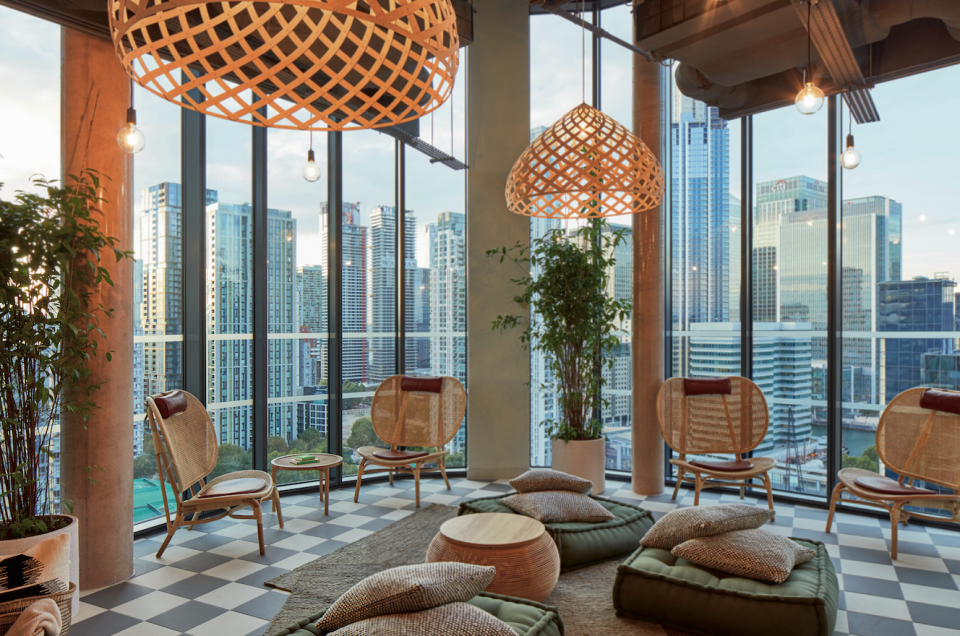Inside ‘co-living’: the flats where millennials trade living space for free craft workshops and yoga

My alarm goes off at 6.30am, which means it’s time for yoga. As I wipe the sleep from my eyes, I glance around the unfamiliar apartment I’ve just spent the night in, which doesn’t take long because it’s barely bigger than a walk-in wardrobe. I get dressed and stumble out the door, traipsing down the stairs behind a row of others dressed in identical kit. We’re directed to the ‘Wellness Pavilion,’ where we start the day with an hour of downward-facing dogs and warrior poses.
Welcome to co-living – the new trend trying to persuade millennials that living in a small, expensive rented room isn’t not, in fact, a total bummer, but a lifestyle choice. It’s not a commune, exactly, but a building where you rent a poky studio apartment and have access to shared social spaces and a roster of ‘fun’ activities to take part in. You also don’t have to bother yourself with such arduous tasks as cleaning up or paying the bills.
A handful of these buildings have sprung up in the capital over the past couple of years, claiming to offer an alternative to dingy house shares and dodgy landlords. As a single 30-something living in London, I’m the target market – so I spent the night in two of them to see what it’s really like to exist in the co-living bubble.
‘A more joyful way of living’
First up is The Italian Building in Bermondsey, a brand-new 28-studio development run by a company called Mason & Fifth. It’s so new the first residents haven’t yet moved in, but I’m promised a taster of the experience they can expect, so I turn up with my overnight bag on a rainy Tuesday, armed with a schedule for the evening’s activities.
Mason & Fifth is focused on ‘wellness’ – take a drink – and promises “a transformational home that connects you to a more joyful way of living”. The building is nice, its interiors all polished concrete and snaking monsteras. But the studios are what you would charitably call bijou at just 170 sq ft, less than half the minimum space standard of 398 sq ft outlined by the Greater London Authority. This is allowed under planning rules because the building was converted from an office.

It’s nicely decked out with hanging plants, ‘quirky’ wall art, Ottolenghi cookbooks and an inexplicable bowl of lemons, but basically just consists of a bed, kitchenette, shower room, wardrobe and a table and chairs. It feels more like a hotel room than an apartment.
Some say it’s just a formalisation of the house shares that city-dwellers in their 20s and 30s begrudgingly find themselves in. An even rosier view is that it harks back to the kind of close-knit communities that people lived in in the past.
“The idea of living collectively is almost ingrained in our DNA and we’ve done it for hundreds of years,” says Richard Lustigman, director of co-living at property consultancy JLL. That might be true, but it hasn’t always been so expensive. It costs £1,650 per month to live here – far more than the average room in a shared house, and slightly more than the average £1,633 rent for a one-bed property in Bermondsey, according to Zoopla.

The reason Mason & Fifth thinks people will pay it is because of the less tangible things the building offers, based around five ‘pillars of well-living’ it has come up with: healthy spaces, daily nourishment, modern fitness, mental clarity and something called ‘conscious hedonism’.
Along with your tiny room you get a big communal living room, kitchen and dining area downstairs, bills included and access to free activities including running clubs, meditation, yoga, gardening workshops, bike rides, a ‘rant and reflect talking circle’ and a ‘mental resilience workshop’. You can also have a chef cook you dinner and packed lunches and have someone do your laundry for an extra fee. The owners predict people will stay for three months to a year.
Free activities include running clubs, meditation, yoga, gardening workshops, bike rides, a ‘rant and reflect talking circle’ and a ‘mental resilience workshop’.
Ben Prevezer, the 30-year-old creative director of the project says the rooms “balance our generation’s growing need for both community and privacy” and enable “meaningful exchanges and generous individual space within the metropolis.”
My evening sampling the co-living lifestyle starts with a paper marbling workshop, then a dinner in the communal area consisting of shared plates of burrata, quinoa, root veg and plaice. We are served ‘social spirits’ from Third Way; strange non-alcoholic herbal elixirs which claim to have ‘active feel-good compounds’.

We have our auras read. When we go to bed, herbal sleeping tablets have been left on our pillows. I take one and it seems to work, which is good because I’m booked in for a yoga class at 7.30am in the “wellness pavilion”, which we all turn up to in our Mason & Fifth branded hoodies. It feels like a new age version of a school residential.
‘Sleepovers are sexy, squatting is not’
Continuing the school theme, there are also lots of rules. When the building opens in January, residents will be given a book full of them. “Sleepovers are sexy, squatting is not,” it proclaims, pointing out that if a partner stays over for more than ten nights in four weeks you may be asked to “upgrade” to a couples room fee. They can also be asked to leave after three warnings if they don’t respect the “calm, relaxed and welcoming environment” of the building.
There are only 28 apartments, and Mason & Fifth will hand pick the residents to try and create a harmonious atmosphere. So far, 800 people have registered interest in The Italian Building, so they’ve got their work cut out.
Over dinner, one of the staff confesses that they’ve been a bit worried about how potential relationships – and inevitable breakups – might ruin the carefully curated dynamic. And that’s the problem with co-living, really: there’s no accounting for the fact that people might want to have an ill-advised hook up with someone in their building, or own more than a couple of suitcases worth of possessions, or just watch TV alone in their apartment on a hungover Sunday, rather than in a communal room with 27 other people.
Here, you have no choice but to be the best version of yourself.

When I walk into The Collective at Canary Wharf, a new 21-storey co-living block which opened three months ago, the first thing I notice is a huge chalkboard with the programme of events for the week. You can add managing our own social lives to the list of things that millennials clearly can’t be trusted with, along with mortgages and cutting up an avocado.
There’s circuit training, a running club, yoga, three film club sessions, a ‘pimp my G&T’ masterclass, a cooking class and a session on how to make a kokedama (a type of Japanese hanging planter). Deep down, I know that the session I would be most likely to attend if I lived here would be the Friday happy hour in the top-floor bar and restaurant, Mthr.
The community manager, Jackson Torchia, shows me around the place. The walls in the communal areas are aptly painted millennial pink, and there are neon art installations everywhere.

There’s a co-working space, a giant living room filled with sofas, a meditation room, a gym, a screening room and a huge kitchen for cooking classes.
We get a lot of young professionals here who are just out of home,” says Torchia, who says recent recipes have included vegetable curries and pumpkin bread. In the next room, an electronic putt returner for practicing golf is being installed. “Not to curse it, but I think our members will use it once and never again,” he adds.
There are fake cobwebs left over from the Halloween party a few days earlier, and just to infantilise things even further, a giant hopscotch grid on the floor
Long-term residents will pay £1,300 per month for a year-long stay in the smallest room here, or up to £2,080 for the space with the highest specification.
All in, the communal spaces take up three whole floors of the building. In the basement is a student-style bar with graffiti on the walls, a DJ booth, ping pong table. There are fake cobwebs left over from the Halloween party a few days earlier, and just to infantilise things even further, a giant hopscotch grid on the floor. “It’s just to get people talking,” says Torchia.

Finally, on the top floor is the incongruous combination of the bar and restaurant, Mthr, which is open to the public, and a pool – the highest in East London – complete with inflatable flamingo.
“One of our members put it in and I didn’t have the heart to take it away,” says Torchia. Conveniently, it’s also the kind of thing that people love to post on Instagram. The only way this could be more perfect is if it was a unicorn.
Social, ‘student’ lifestyle
The people trying to sell the co-living lifestyle say it addresses two of millennials’ biggest reported problems: bad housing and feeling lonely. There’s definitely a community here – and it’s strikingly similar to the one you might find in a student halls of residence. Strangers say hi to me when I get in the lift, friends bump into each other in the hallways and there are clusters of people hanging out in most of the rooms I pop my head into.
The similarity to being at university isn’t lost on the people that live there, either. “It appealed to me to be able to live a more social lifestyle, more akin to my uni days – that’s something that I missed since I graduated,” says 28-year-old software programmer Jonas Hou, who has just moved here after living in The Collective’s sister building in West London for a year and a half. “I came to London five years ago from Germany, and because I didn’t grow up here it’s not like I have a clique of old friends.”

He says it’s better than the flatshares he used to live in, but anyone who’s navigated the minefield of aggressive WhatsApp groups and broken boilers that is the standard London flatshare will know that’s not particularly hard.
My apartment here is a bit bigger than at Mason & Fifth, but I still wonder where I’d put all my stuff, as the storage amounts to a small-ish wardrobe, kitchen cupboards and a few shelves. Whoever designed this room has clearly taken to heart the oft-spouted marketing edict that millennials value experiences over possessions.
Co-living isn’t for me. Admittedly, that’s partly because I’m too miserable – I don’t like waking up early to do yoga, and I can barely be bothered to socialise with my existing friends on a Tuesday night, let alone make new ones. But you can’t hide the fact that these buildings are expensive and don’t offer enough private space.
Unless co-living can overcome one or both of these problems, it’s not going to be an option for the average twenty-something renter – no matter how many yoga classes and hanging plants you throw at them.